The 2018 Municipal Elections: “Mixed” but Unequal
Comparitively low representation of Arab residents in the municipal government of “mixed” cities adversely affects their trust and sense of belonging as well as their affinity in the municipality.
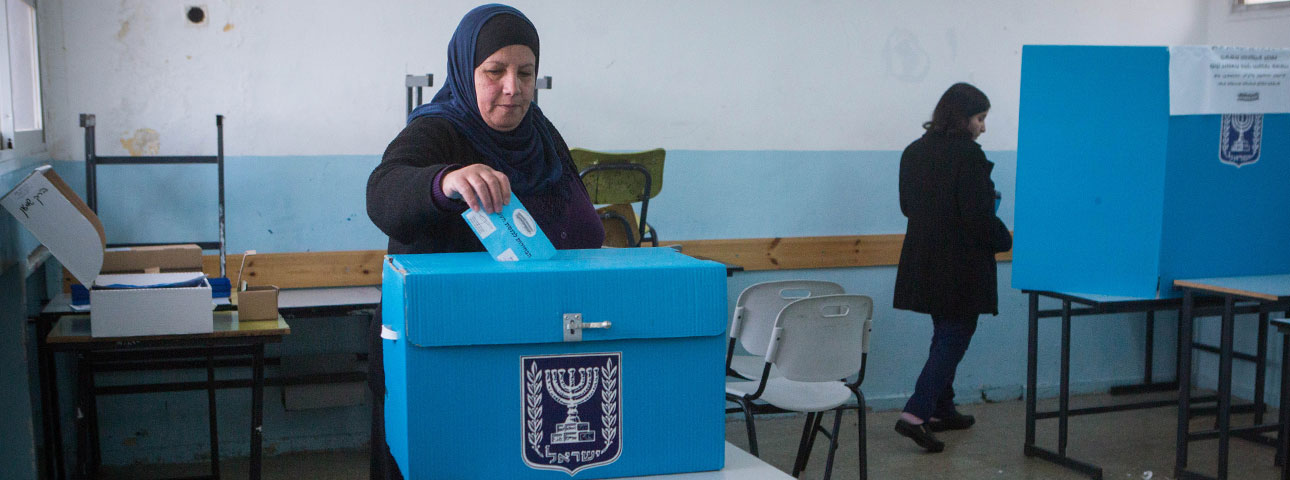
Flash 90
What Is a Mixed City?
A mixed city is an urban locale populated by residents from different ethnic or religious origins, and in which the minority group comprises more than 10 percent of the city’s total populationCentral Bureau of Statistics, Statistical Abstract of Israel 64 (2013): 84.. In addition to the differences between them, the groups that live in the city share an important common denominator: the wish to live in an urban locale that will supply all that they and their children need, including housing, employment, education, and welfare.
In Israel, the percentage of Arab-Israelis moving to mixed cities has increased markedly over the past several years. Currently, more than 10 percent of the Arab population lives in mixed cities.
Separate Communities in Mixed Cities
Within the broad topic of mixed cities, this paper focuses on the specific issues of separation in the labor market and in municipal political representation on 3 levels: city employees, city council members, and deputy mayors in mixed cities. Such separation takes two forms: under-representation of the Arab residents on all these levels, as well as in the designation of the high-ranking jobs and roles (generally speaking) to Jews, and the lower-ranking ones to Arabs. The time has come to examine the degree to which Arabs are represented at the professional and political levels of municipalities and the manner in which the municipalities fill these positions. Our recommendations following this examination are presented at the end of this article.
The Differences between Jews and Arabs at the Municipality’s Professional and Political Levels
It is clear that this separation among municipality employees, city council members, and deputy mayors is extremely problematic, in as much as it lays the groundwork for widening the multi-dimensional gaps between Jews and Arabs in mixed cities.
Our study is based upon up-to-date statistics that we received in response to requests made under the Freedom of Information Law in June 2018 to all the mixed cities in Israel, on reports published by the Knesset Research and Information Center, and on a doctoral dissertation that was written on the subjectHanan Cohen, “Crumbling Control: Majority-Minority Relations in Local Politics in Mixed Cities in Israel” (PhD diss., The Hebrew University of Jerusalem, 2018; Hebrew)..
Our findings lead to two main conclusions:
1. There has been a slight improvement in the representation of the Arab minority among the municipality employees of all mixed cities.
2. Appropriate representation of the Arab minority among employees of the municipalities, city council members and deputy mayors is still a long way off, since there is still an imbalance between the percentage of the city’s Arab residents among the city’s total population, and their representation in the municipality. Many positions at the professional and political levels in the mixed cities are still not filled by Arab residents.
In other words, Arab and Jewish residents are “mixed”, but not equalThis is a paraphrase of the title of an article that appeared on the +972 website: “Mixed Arab-Jewish Cities in Israel: Not Separate and Not Equal.” That title, too, was taken from the well-known ruling in the United States Supreme Court case, Brown v. Board of Education..
Representation of Arabs at the Professional Levels of Municipalities
| % of Arab residents of total city population | Number of municipality employees | Number of Arab municipality employees | % of Arabs among municipality employees | % of Arab residents of total city population | Number of municipality employees | Number of Arab municipality employees | % of Arab employees of the total municipality employees | |
| Tel Aviv-Jaffa | 4.40% | 6,794 | 158 | 2.20% | 4.40% | 9,855 | 355 | 3.60% |
| Haifa | 10.20% | 4,623 | 572 | 12.30% | 11.20% | 5,606 | 843 | 15.00% |
| Ramle | 23% | 727 | 46 | 6.30% | 23% | 1,507 | 180 | 12% |
| Upper Nazareth | 15.20% | 514 | 20 | 3.90% | 24.50% | 516 | 25 | 4.80% |
| Ma’alot-Tarshiha | 22.20% | 406 | 78 | 19.20% | 20.80% | 492 | 114 | 23.10% |
| Acre | 28.30% | 550 | 83 | 15% | 31.40% | 504 | 103 | 20.40% |
| Lod | 24.90% | 817 | 92 | 11.20% | 30% | 1,242 | 170 | 13.60% |
| 2008 | 2018 |


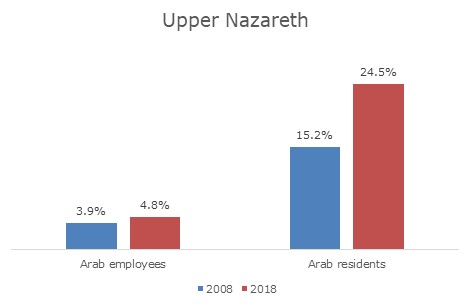
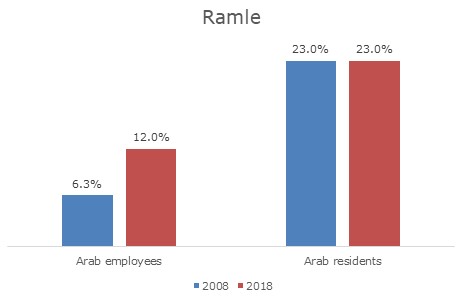

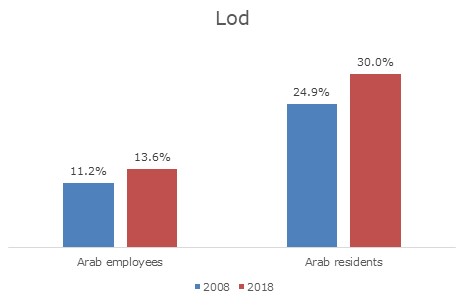
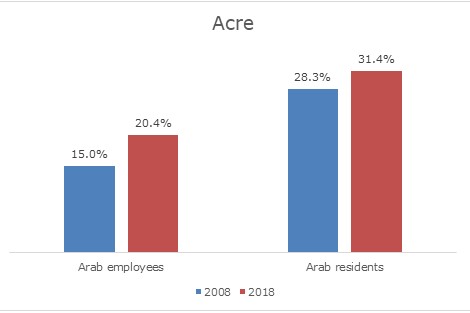
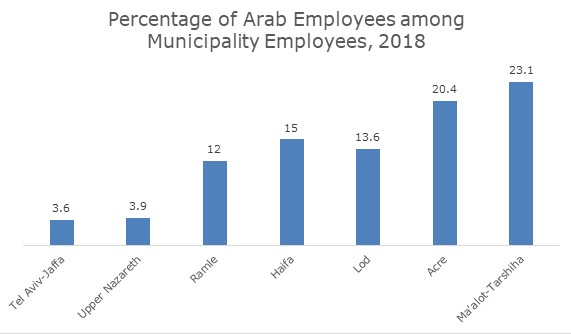
The representation of the Arab minority in the professional levels of the municipality improved over the past ten years in all the mixed cities except for Tel Aviv-Jaffa. It increased by 6% in Ramle, 5% in Acre, 4% in Ma’alot-Tarshiha, and 2% in Lod. Yet despite this improvement, there is still an imbalance between the percentage of Arab residents among the total population in mixed cities and their representation among professional employees in the municipalities. Furthermore, the majority of high-ranking positions are filled by Jews.
This is not only a matter of under-representation in the highest-ranking and highest-paying positions, but also in other positions that have a great deal of influence on the city’s functioning, such as division heads and department heads. Moreover, according to the responses we received to our requests for information under the Freedom of Information Law, the new Arab employees who were hired to work in the municipalities of mixed cities during 2018 were placed mainly in low-ranking positions. In the Acre municipality, for example, the Arab employee who was hired was given a job collecting trash, while the Jewish employees fill positions such as attorneys, psychologists, social workers, recycling and sanitation coordinator, driver, and administrator. The situation definitely requires re-thinking of best practices to ensure appropriate representation of the Arab population among municipal employees in mixed cities, as well as developing a track toward filling high-ranking positions that are currently closed to them.
City Council Members in Mixed Cities, 2018
| % of Arab residents of total city population | Number of city council members | Number of Arab city council members | % of Arab city council members of e total number of council members | |
| Tel Aviv-Jaffa | 4.40% | 31 | 1 | 3.20% |
| Haifa | 11.20% | 31 | 3 | 9.60% |
| Ramle | 22% | 17 | 3 | 17.60% |
| Upper Nazareth | 24.00% | 17 | 2 | 11.70% |
| Ma’alot-Tarshiha | 20.80% | 14 | 3 | 21.40% |
| Acre | 28.10% | 17 | 5 | 29% |
| Lod | 30.00% | 19 | 4 | 21.00% |

Our examination indicates that as of 2018, a disparity between the percentage of Arabs among the city’s total population and their percentage among city council members in all the mixed cities except for Acre and Ma’alot-Tarshiha, with the largest disparities in Lod (30%) and Upper Nazareth (24%).
Along with under-representation among municipality employees, there is also under-representation in city council membership. This situation arouses the concern of inadequate allocation of resources by the municipalities, needed to narrow the social and economic gaps between Jewish and Arab residents, since there are no Arab members on the city council to push for increasing budgets designated to this purpose. Past experience shows that under-representation of the Arab population in decision-making roles is fertile ground for using the municipality’s power to push the Arab population aside and discriminate against itOf course, this statement also applies to representation in the rest of the Civil Service. See Lila Margalit, “Integrating the Arab Population into Decision-Making Positions in the Public Sector,” Parliament, 2017 (Hebrew)..
Arab Representation at the Rank of Deputy Mayor in Mixed Cities, 1978–2016
| Haifa | Lod | Upper Nazareth | Acre | Ramle | Tel Aviv-Jaffa | |
| 1978–1983 | 100.00% | 1 | 1 | 200.00% | 100.00% | 1 |
| 1983–1989 | 100.00% | 1 | 1 | N/A | 100.00% | 1 |
| 1989–1993 | 100% | 1 | 1 | 200.00% | 100% | 1 |
| 1993–1998 | 100.00% | 1 | 1 | 200.00% | 100.00% | 1 |
| 1998–2003 | 300.00% | 1 | 1 | 200.00% | 100.00% | 1 |
| 2003–2008 | 200.00% | 1 | 1 | 200% | 100.00% | 2 |
| 2008–2013 | 300.00% | — | 1 | 200.00% | 100% | 1 |
| 2013–2016 | 2 | 1 | 3 | 2 | 1 | 1 |
1: Jewish deputy mayors only, salaried
2: A Jewish deputy mayor and an Arab deputy mayor, salaried
3: A Jewish deputy mayor and an Arab deputy mayor, not salaried
Hanan Cohen looked into the ethnic identity of deputy mayors in mixed cities (excluding Ma’alot-Tarshiha) and in other cities)Hanan Cohen, “Crumbling Control.”. He wrote: “The appointment of a deputy mayor from a minority group… testifies to the actual influence of the ethnic group on the way the city’s affairs are run.” His table, which is shown above, demonstrates that in this area too, it is important to make sure that the Arab minority is adequately represented. A bill addressing this issue has been proposed in the Knesset.
Our Recommendations for Change
On the three levels in which we examined the representation of Arabs in mixed cities — among municipality employees, city council members, and deputy mayors — we found a necessity for radical system-wide reforms, as well as for taking measures to change the current situation.
1. Appropriate Representation among Municipality Employees
A. The disparity in this area requires an integrated process for ensuring appropriate and effective representation for the Arab population among municipality employees in mixed cities.
• Instituting a requirement for appropriate-representation of the Arab population among municipal employees in mixed cities
• Setting concrete goals for the representation of the Arab minority among municipality employees in mixed cities.
• Promoting The Arab population toward filling high-level positions in the municipality.
B. The representation requirement must be given legal status.
• The Arab population must be included in this legislative amendment, thereby ensuring its representation in mixed cities, at least according to the Central Bureau of Statistics (CBS) definition of such cities.
• Once the amendment passes, concrete goals for representation must be set. The point of departure should be to strive for a match between the percentage of Arabs in the city’s population and the percentage of Arab employees among the total number of employees in the municipality.
C. Allocating targeted tenders for the Arab minority so as to ensure a significant increase in the percentage of Arabs in higher-ranking municipality positions (division heads and department heads).
• Regarding the issue of the highest-ranking positions (such as director general, legal counsel, comptroller, engineer, and treasurer), a procedure or guideline must be instituted according to which at least one of these positions must be filled by an Arab employee.
D. Establishing a tailored cadet program in universities for future employees in Arab and mixed municipalities. This is an additional tool with potential to make a real difference in the long term.
Alternatively, existing programs must be responsible for
• Setting a high bar for the representation of Arabs in local government leadership reserve programs
• Allocating and designating resources for identifying suitable candidates among residents of mixed cities. Such recruitment will add new employees to the municipalities’ work force who, in the future, will fill high-ranking positions.
2. Appropriate Representation among Members of the City Council
A. Under-representation of the Arab population among city council members in mixed cities
• The existing legislation aimed at creating incentives for representation of women on party lists for municipal elections should be applied to the Arab populationSee the proposal for Amendment 12 of the Local Authorities Law (Funding of Elections) (2014). The purpose of the proposed amendment is to “promote equality between the sexes and encourage the representation of women among those elected to the local government by increasing the amount of funding allocated to a faction or list with appropriate representation for women.” The means for this is a 15-percent addition to the funding set by the Local Authorities Law if “at least one-third of the municipal council members are women.”. If joint lists in mixed cities are to receive additional funding as an incentive for appropriate representation of the Arab population, it is reasonable to assume that there will be a marked increase in the representation of Arabs among council members. Another benefit of this measure will be the encouragement of joint Jewish-Arab lists, as a result of increased trust on the part of the Jewish and Arab populations in coexistence in the mixed city.
• Special incentives must be provided for the representation of Arab women, who are particularly under-represented on city councilsRinat Benita and Shelly Mizrachi Simon, Appropriate Representation of Women in Local Government: The Situation in Israel and a Comparative Study (Knesset Research and Information Center, 2018).. Creating incentives for lists that include Arab women is justifiable under both the statute mandating incentives for including women, and the statute mandating incentives for including Arabs on candidate lists for municipal elections.
3. Appropriate Representation among Deputy Mayors
The Arab population in mixed cities also suffers, as noted, from under-representation among deputy mayors. A bill has been proposed in the Knesset to address this disparity. The statements that were made in the Knesset plenary provide the best example of why this is so necessaryMK Osama Saadi (Joint List) in a Knesset debate on the Local Authorities bill (Election of the local-authority head and his or her deputies, and their term of service) (Amendment — Deputy local authority head in a mixed authority), 2016 (submitted to the Knesset speaker and the deputies and proposed in the Knesset on January 4, 2016):
I submitted this bill together with my friend David Amsalem, chairman of the Internal Affairs Committee. This bill came into existence after the Internal Affairs Committee, headed by David Amsalem, visited the city of Lod, where we toured the Arab neighborhoods, the al-Mahata neighborhood, the Rakevet neighborhood, and others. We also met with the mayor and with the Arab members of the city council. It was then that the question came up as to why there was no deputy mayor who would deal with the conditions and issues of the public from which he was elected and that he represented. I cited the example of Jerusalem, which has seven or eight deputy mayors, in order to give representation to all segments of the population, so there really are more deputy mayors than required by law. And so this idea came up: that we would submit a bill together, after visiting the city of Lod, and work together to move it forward.
. The explanatory notes that appear in the bill present the problem without embellishment and state that “in the mixed cities, where a religious or ethnic minority exists, there is a problem with the representation of the minority.” The example cited there is the Lod municipality, where “the deputy mayors elected by the Lod city council were chosen from other factions [that contain no Arab candidates] due to the need to assemble a coalition. As a result, the Arab minority in that city, which is greater than 25%, is not represented in the municipal leadership.”
The above bill should be adopted with one required change: the threshold that was set in the bill — “A municipality in which at least 20% of its residents, but fewer than 50% of them, are members of a minority group” — should be changed to 10% so that in mixed cities in which the percentage of Arab residents is small will also have appropriate representation.
4. Establishment of an inter-ministerial department to formulate general recommendations for mixed cities
Our recommendations will be of greater value if they are part of a comprehensive program for mixed cities. A call was made in the Knesset as early as 2008 to establish an inter-ministerial department for mixed cities that would formulate a plan of action and concrete recommendations, such that these cities would be a “focal point of coexistence instead of a focal point of problems and troubleInternal Affairs Committee, “The establishment of an interministerial department for the mixed cities,” July 1, 2008..” But no such department has been created. With no proper programs put in place, Arabs in mixed cities have not received any real attention in the Knesset building to this very day, nor have any concrete proposals on the issue been made, with the exception of Government Resolution No. 2710 for “strengthening individual safety in the mixed cities.”
Conclusion
Our recommendations for rectifying the under-representation of Arab residents among city council members, municipal employees and deputy mayors in the mixed cities have to do, to a large extent, with the central government.
ON this issue, the central government must act as follows
1. Define appropriate representation of the Arab population among municipality workers in mixed cities as a legal requirement, anchored in law
2. Create, by law, incentives for political lists in mixed cities to ensure appropriate representation for Arab residents among city council members.
3. Define the appointment of Arab deputy mayors in mixed cities as a legal requirement
4. Establish an inter-ministerial department to deal with mixed cities
5. Adopt a government resolution regarding mixed cities
Needless to say, we must not ignore the responsibility of the municipalities themselves. Municipalities must collect data that are segmented by ethnicity to enable the mayor to fully understand the problem of the disparities between Jewish and Arab residents, and allocate designated high-level positions for Arab employees. In addition mixed cities and their mayors should adopt, and even impart to their residents, the concept of coexistence and a shared society between Jews and Arabs. Ugly statements against the Arab population by mayors in recent years need to fade into the past and stay there“If they don’t like it, they can go live in Jaljulia — that’s an Arab name. What’s he on about? What? Why should I change the name because some Jamal or some Muhammad wants me to do that? Let him change his God. What’s he on about?” (Yael Kishik, “Mayor of Ramle apologizes for racist remarks,” Walla!, November 30, 2006). In addition to his opposition to changing the names of streets in the city, the mayor of Ramle suggested changing the name of the city, saying, “The name is worthless” (Benny Nurieli, “On dominance and hegemony in mixed cities in Israel,” Jama’a 18 (2010): 229 (Hebrew).
Shimon Gafsou, the mayor of Upper Nazareth, also spoke crudely about the Arab population: “If I had been in the riots of October 2000, I would have had more kills.” He added: “I’m not calling upon the Arabs to come and live in the city of Upper Nazareth because Upper Nazareth is a city for Jews” (Jackie Houri, “Mayor Gafsou: Upper Nazareth is a city for Jews only” (Haaretz, June 5, 2011).
. We call upon the mayors and those in leadership positions to invite the Arab population to become active partners in the city’s management, instead of treating them like uninvited guests in their own cities. In addition, it is important to note that appropriate representation for Arab residents of mixed cities among municipal employees, city council members, and deputy mayors has a symbolic value, since it signals that the mayors and leadership of mixed cities are committed to all the residents for whom they are responsible, Jews and Arabs alike, rather than only to the Jewish majority. The appropriate representation of all the city’s residents around the decision-making table will be an important step towards a more ore egalitarian city.
Moreover, Section 7 of the Basic Law: Israel as the Nation-State of the Jewish People (2018), states: “The state views the development of Jewish settlement as a national value and will act to encourage and promote its establishment and consolidation.” By process of elimination, we can conclude that the state attributes no national value, or any sort of value at all, to mixed citiesJust recently, in a demonstration in Afula against selling a home in a “Jewish” neighborhood to an Arab family, a candidate for the city council who attended the demonstration said: “I blame the city’s leadership for this move toward making this a mixed city, which will cause endless trouble” (Noa Shpigel, Haaretz, and June 14, 2018).. Therefore, the importance of partnership between Jewish and Arab residents of mixed cities cannot be exaggerated. Full partnership will be the proof that divisiveness and incitement will never succeed in destroying life in the public space shared by Jews and Arabs alike.
This study has been published as part of a special series by the Israel Democracy Institute on the occasion of the 2018 municipal elections.
